Best Orthotics for Toe Walking – These Shoes and Orthotics Help Prevent Toe Walking!
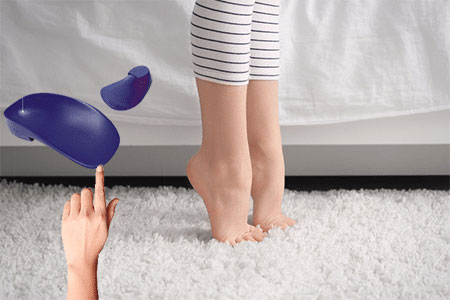
Have you taken your child to your medical professional and were told that your child’s toe walking will eventually stop? I have helped several children who were walking on their toes and are now walking the correct way —heel to toe— and I believe I can help your child too. The best orthotics for toe walking work by addressing the underlying causes of toe walking, which can improve balance, posture, and overall walking patterns.
As a dedicated shoe fitter with years of experience, I understand the concerns that arise when parents notice atypical walking patterns in their children. Please note that early intervention in children who toe walk is key to preventing this condition from getting worse.
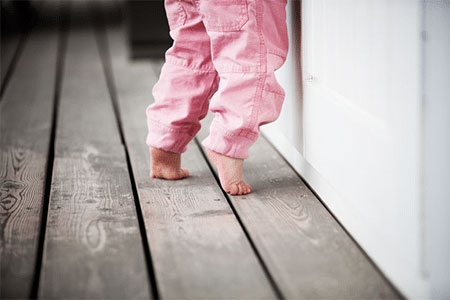
Be Proactive and Don’t Assume the Condition Will Magically Disappear
I always recommend parents to be proactive and start treating this condition from an early stage as this highly decreases your child’s necessity for more invasive treatments such as serial casting, Botox injections, or surgery in later childhood. Taking the “wait and see approach” and waiting for the condition to resolve on its own may only lead to the condition getting worse.
Children between the ages of one and five undergo rapid neuromuscular development and toe walking during these years can often be easily managed with proper foot orthotics and correct footwear. Unresolved toe walking after age five or older, although still manageable, can become a bit more difficult to control.
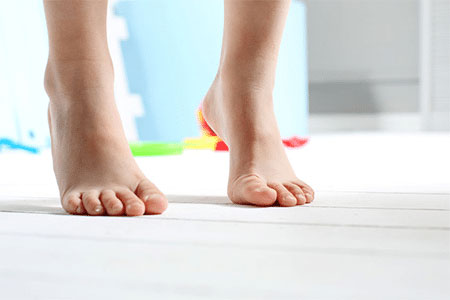
The longer the child continues to toe walk may lead to a sustained habitual pattern and ultimately risk of acquired tendon tightness and ankle stiffness.
Is It Normal for Toddlers to Walk On Their Toes?
Keep in mind that is common to see toddlers who are learning how to walk, get on their toes, and in most cases, toe walking reduces and is of no concern. However, I suggest that parents keep a close eye and be proactive if they don’t see this condition improve. Children who toe walk might experience frequent falls or stumbles with ambulation, another reason why parents shouldn’t leave this condition untreated.
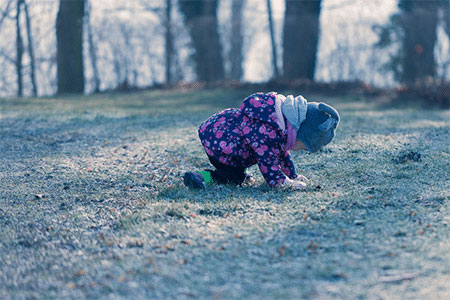
Toe walking also becomes a problem when the calf muscles begin to shorten, reducing your child’s ankle movement. Toe walking can cause long-term damage to the foot and ankle due to the abnormal forces acting on them.
Keep in mind that pain is not the only reason to treat! Toe walking is not a painful condition, and just because the child doesn’t complain about pain it doesn’t mean it should be left untreated or that the child will outgrow the condition.
My Experience Helping Toe Walking Children
I have helped improve the walking gait of several children who were toe walking by fitting them in the correct types of shoes and orthotics. I want to clarify that I am not a doctor, I am a shoe fitter who has over a decade of experience fitting children in shoes and orthotics.
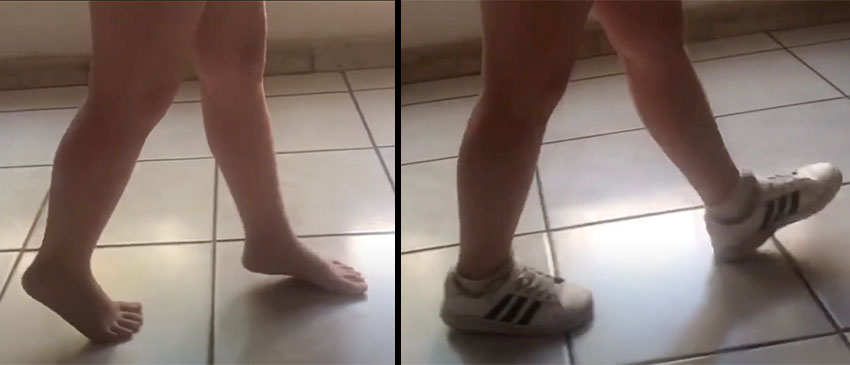
My goal has always been to use the minimal intervention that is effective, that is the reason why I always recommend to start by trying a pair of supportive shoes and orthotics and leaving casting and surgery always as a last resort.
Why Do Kids Walk on Their Toes?
Did you know that most doctors can’t identify the reason why children toe walk? Persistent toe walking is referred to as “idiopathic,” which means that the exact cause is not known, and the child continues to toe walk because has a preference to do so. I disagree with this statement as I have always found there is a specific reason why the child’s toe walks.
Four Most Common Reasons Kids Walk On Their Toes
1. Flat Feet: Children with flat feet have poor balance and coordination. To combat this, children might raise up on the toes to put the foot in a more stable position. Toe walking enhances the arch which creates a more stable foot (base) and temporarily improves the child’s balance and stability. This however is not normal and promotes improper muscle balance development and needs to be addressed.
2. Short Achilles tendon: A short Achilles tendon can prevent your child’s heels from touching the ground.
3. Sensory perceptions: Check the surface your child is walking on. Maybe the child doesn’t like the feeling of the cold tile or furry carpet and this exaggerates the symptoms.
4. Vision impairments: A short vision check with tracking and convergence can be helpful. Some children are required to go to vision therapy to strengthen their eyes. Many vision specialists say that they see a lot of kids toe walking with vision issues.
In my experience, most children walk on their toes due to having flat feet. I would say that 80% of the toe walking children I have helped were flat-footed.
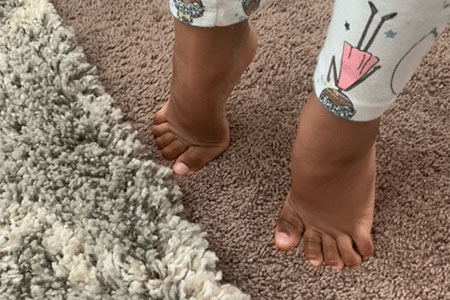
One thing is clear, whatever reason might be causing your child to keep toe walking, you need to take action immediately. Please trust me that taking action early is key to preventing future problems for your child. Look at it this way, when children toe walk, they are doing something that is biomechanically incorrect, and that will have a lasting effect on your child’s muscle structure.
Follow My Two Step Approach to Correct Toe Walking
Below you can find my simple two step approach which has prevented several children from walking on their toes.
First Step: Trying a Pair of Orthotics
Orthotic inserts are pivotal in correcting toe walking, as they provide the necessary support and alignment to encourage proper foot placement during walking. By ensuring that the foot is correctly aligned, orthotics can help in redistributing pressure across the foot, promoting a more natural gait cycle.
I have fitted one specific orthotic that has proven to be the most effective one for treating and preventing children from walking on their toes. The orthotic I recommend provides the following features:
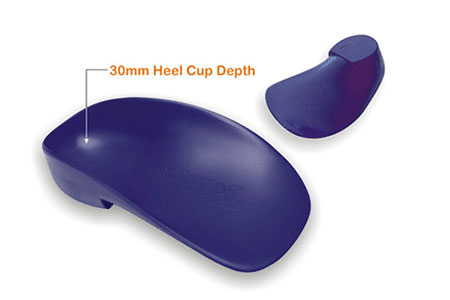
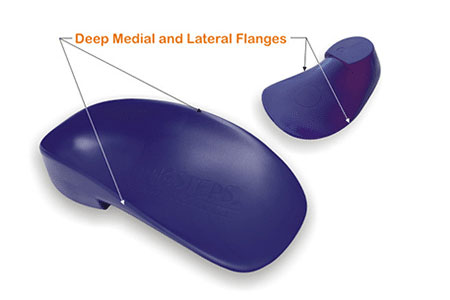
Best Orthotics for Toe Walking
This is the best prefabricated on the market for helping treat, prevent, and control toe walking. Keep in mind that works well for a child who toe walks might not work as well for another, so it’s important to keep an open mind and try different approaches.
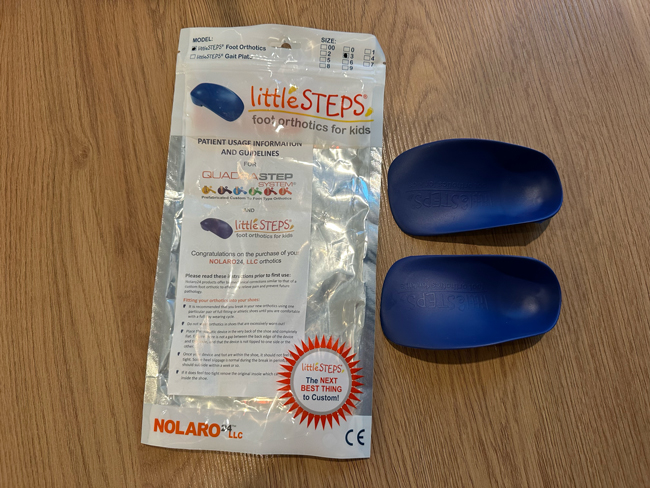
- Order littleSTEPS® Orthotics from their official website. You must submit a Referral Code to complete your order: JVFCS100121
- It’s not necessary to remove the original insoles of the shoes when fitting this orthotic.
- The 3/4 length design makes it easier to fit into various shoe styles.
- Take a look at this chart to figure out what size to order based on your child’s shoe size.
Please note that how effective this orthotic will be in preventing your child’s toe walking condition depends on your child’s age and your child’s individual foot anatomy.
Second Step: Trying Supportive Shoes
I have noticed that the most effective anti toe walking shoes meet the following three checkpoint criteria:
1. Avoid shoes that are too flexible: Shoes that provide too much flexibility make it easy for children to get on their toes. Make sure that the shoes your child wears are flexible but not too flexible. Your kids’ shoes should always bend at the ball of the foot but no further:
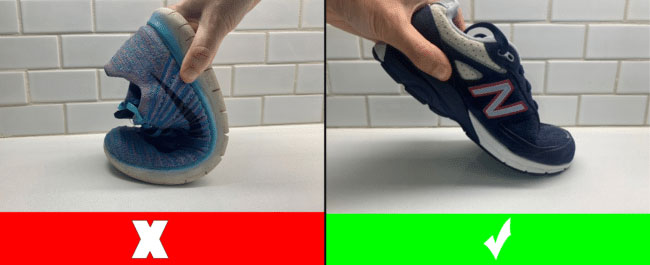
2. Find Shoes with a Stable Base of Support: Some children raise on their toes to help improve their poor balance and coordination. Shoes that provide a stable base of support can help put your child’s feet in a more stable position and improve your child’s balance and stability.
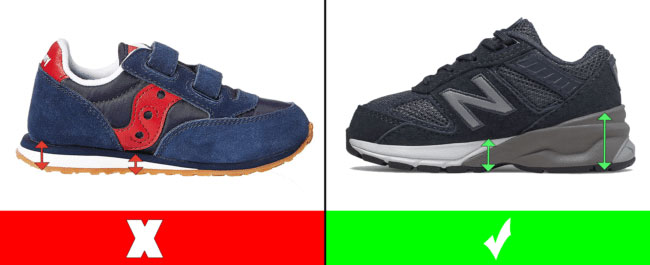
3. Firm Heel Counters: A firm heel counter helps stabilize the foot and supports the orthotic in promoting heel strike. This feature is crucial for maintaining proper alignment and encouraging a natural gait.
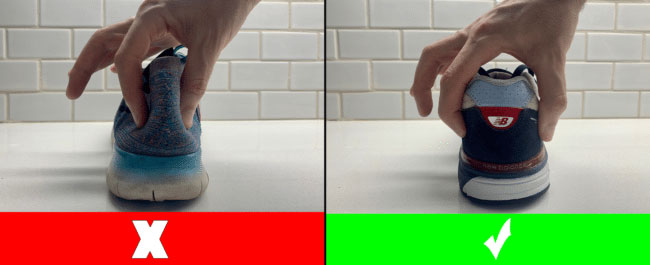
Choosing the Right Anti-Toe Walking Shoes for Kids
Orthotics alone may not be sufficient to correct toe walking; the right pair of shoes can greatly enhance the effectiveness of orthotic inserts. I created a different resource that has a list of anti-toe walking shoes that provide a stable base of support and are rigid at the front to help discourage toe walking.
Get in Touch for a Personalized Shoe Recommendation
As a shoe fitter, I offer tailored advice based on your child’s unique foot shape and walking pattern. If you have any questions or need any further assistance, you can also contact me via email and I will get back to you as soon as possible. I am happy to help you find a different pair of shoes for your child so don’t hesitate to reach out if you have any questions.
Are littleSTEPS Orthotics Better Than AFOs or SMOs?
They are definitely less bulky. Many medical professionals told me that these orthotics have a better carryover effect once children are out of the device compared to children who wore an articulated AFO that completely blocked plantar flexion at the ankle joint.
Another benefit of this orthotic is that it encourages rather than force the child into a normal gait pattern, which means that children use their own muscles to walk rather than relying on orthotics or braces.
How to Order the Correct Shoe Size – In Two Simple Steps!
Proper shoe sizing is crucial for orthotics to work effectively. I provide resources to help determine the correct size when ordering online. A correctly sized shoe ensures that the orthotic fits properly and functions as intended.
The shoes can’t be too big, which means that we have to compromise on the amount of growing room that we provide for your child. Shoes that are too big make it easier for children to get on their toes. I created a virtual shoe fitting service that will help you retrieve your child’s exact shoe size from home.
Final Thoughts on Toe Walking Children
Kids walking on tippy toes is common until a certain age, but it’s important to be proactive because the older your child gets, the harder the condition will be to manage. Providing your child with the correct type of shoes can make a big difference, but providing your child with the correct type of shoes and orthotics highly increases the chances of preventing children from walking on their toes.
Please remember that I am not a medical professional and my experience comes from fitting children’s shoes and orthotics at a specialized local children’s shoe store. Seek advice from a pediatrician, physical therapist, or orthotic specialist to determine the underlying cause of toe walking and appropriate interventions.
Have you found a specific orthotic or shoe that has worked well in preventing your child from toe walking? Let me know what you consider to be the best orthotics for toe walking so other families can benefit from your experiences.

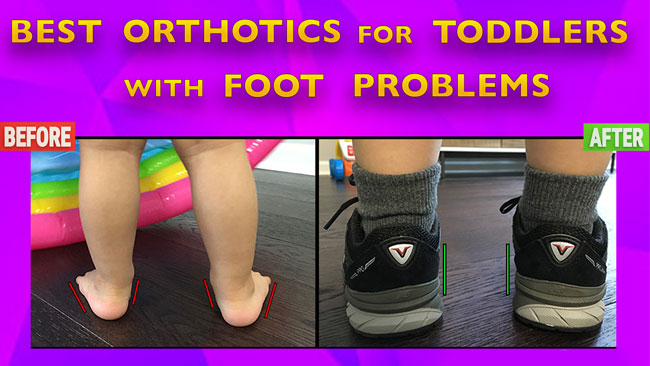
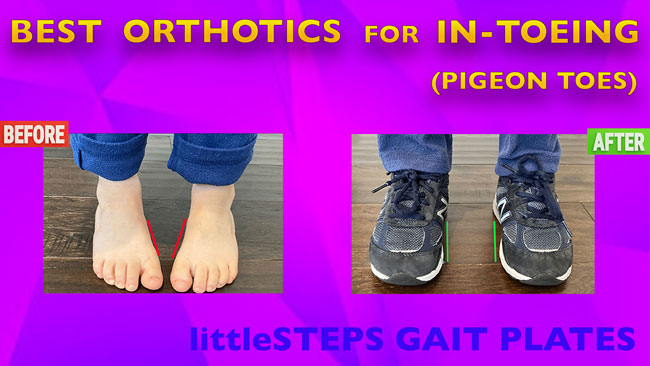
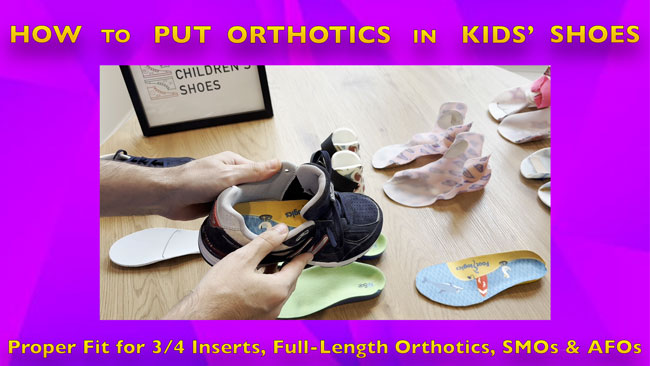
Amazing Such an improvement
Hello Melody,
Yes, it’s pretty amazing what a difference the correct pair of shoes and orthotics can make.
Amazing
¡Hola! Me llamo Laura y estoy encantada de saludarte.
Quería escribirte porque me ha parecido interesante comentar contigo la posibilidad de que tu negocio aparezca cada mes en *periódicos digitales como noticia* para posicionar en los primeros lugares de internet, es decir, con artículos reales dentro del periódico que no se marcan como publicidad y que no se borran.
La noticia es publicada por más de sesenta periódicos de gran autoridad para mejorar el *posicionamiento de tu web* y la reputación.
¿Podrías facilitarme un teléfono para ofrecerte *hasta dos meses gratuitos*?
Gracias
Hola Laura,
Para este tipo de consultas por favor contacte este email: customerservice@fittingchildrenshoes.com
Hi, My daughter has a mild case of MD (congenital myopathy//weakness in her hips & legs) and thus has tiptoe walked since she started walking. She is now 12. She is being put in casts right now to slowly stretch and move her to flat foot. When the casts come off, they want to fit her for a AFO. This is the 2nd time we are doing the casting/AFO as she reverted back to tip toe walking after the first time we had this done 1 year ago. The AFO was very uncomfortable for her and as a result, she did not wear it as she should have. We don’t want her to go through this again so I wanted to post here to see if you felt your orthotics could be the solution. They look so much more comfortable than the AFO’s and are hidden in the shoe (which at 12 years old would be much appreciated for my daughter). Do you feel these would work as well as an AFO to keep her flat foot after her casts come off? I appreciate your feedback and thank you in advance.
Hello Becky,
While AFOs can be great devices for treating and supporting different foot problems, they can also provide issues of their own, such as the one you mentioned with shoe-fitting struggles. AFOs can also cause skin irritations (blisters, redness, sores), bulky/uncomfortable feeling, difficulties putting AFOs on and off.
You can definitely try the littleSTEPS orthotics that I recommend or a carbon fiber footplate, which will also be hidden inside the shoes and they are really effective to help treat toe walking. Whichever orthotic you decide to try, make sure that it’s fitted inside the correct pair of shoes so your daughter can get the full benefits that the orthotics have to offer. Feel free to continue this conversation via email: fittingchildrensshoes@gmail.com
Thank you for the information you provided. Although the items did not provide the help I wanted for my son, I appreciate that in my time of need, I found this site
I am sorry to hear that the shoes or orthotics did not work for your son.
Hi I am parent of 15 yrs old child and he had started toe walking around 2byrs and we had done physio which helped but it did not improved much so we had gone for surgery then a physiilo around 6-8 month in which he had become fine but during lock down his height increase drastically and he again started toe walking his issue is with shirt tendon as per his doctor . We have started physio again but doctor mention his left foot it’s almost 15degree up which would be solved only by surgery. We took other opinion and they mentioned as still his height will shoot continue physio for a year along with it have him wear supporting shoes. Can you guide. I am from India
Hello Rakesh,
My area of expertise is how to treat toe walking by fitting the child in supportive shoes and/or orthotics. If I understand correctly, one of your medical professionals suggested to continue doing physiotherapy for a year and fit your son in supportive shoes.
Have you been told by your medical professionals whether your son’s toe walking is due to a neurological or neuromuscular condition? Do you know if your son has flat feet?
I can help you find the correct pair of shoes for your son but first I need to know whether your son has narrow, medium, wide, or extra wide feet. I also need to know if your son is flat footed or not.
I noticed that you also sent me an email so we can continue our conversation there.
Thank you for addressing this issue. We have tried AFOs with no luck so it’s good to know there is an alternative orthotic that might help prevent my child from toe walking. Another parent recommended your website because it was very helpful for her child. Is there an email address I can contact you?
Hello Dozzy,
I am happy to help: fittingchildrensshoes@gmail.com
It does not seem that medical professionals are giving this much attention in the early stages of the problem. I agree with you about taking early action. I keep hearing stories from parents who took their children to their doctor but they are told to wait, but some children end up needing physical therapy or even surgery because when they are older it’s harder to treat. I am sharing your article with a Facebook group of parents of children who toe walk, I hope that’s okay with you.
Sure, I am happy to help!
Thank you for this. I was told that my nephew will outgrow toe walking but it never happened. We wasted valuable time and left the condition untreated and now we are hoping the shoes and orthotics you recommend will work. Thank you for raising awareness and I will keep you updated on his progress.
Sounds good! Make sure the shoes are properly tied at all times and apply this specific shoe lacing technique:
How to Tie Shoes with Orthotics – Stop Heel Slippage
Dear Juan,
I’d like to express my deepest appreciation for the excellent services you have been providing for my son , all for free.
Thank you,
I will keep you updated.
Regards
Lovelyne
It’s my pleasure! You are doing the right thing by being proactive and taking early action. Hopefully we will see your son walking gait improve in the upcoming months.